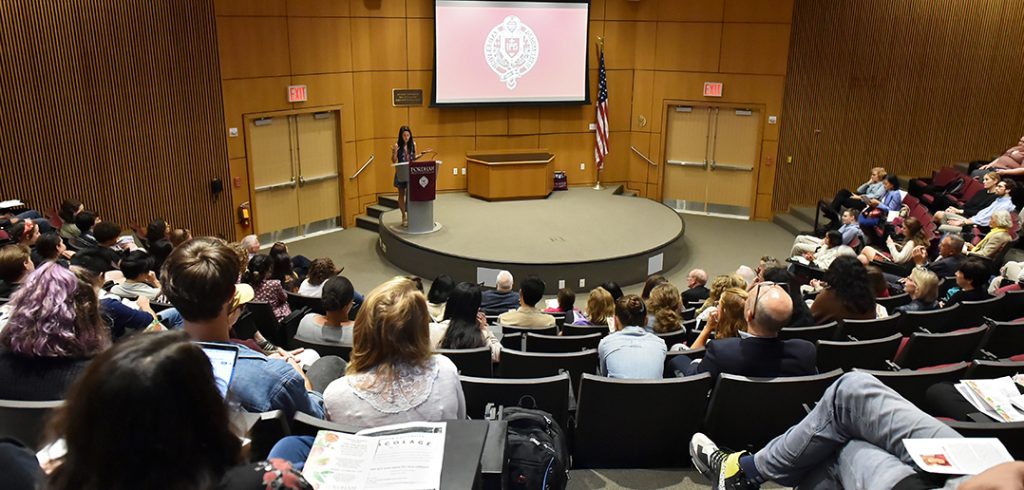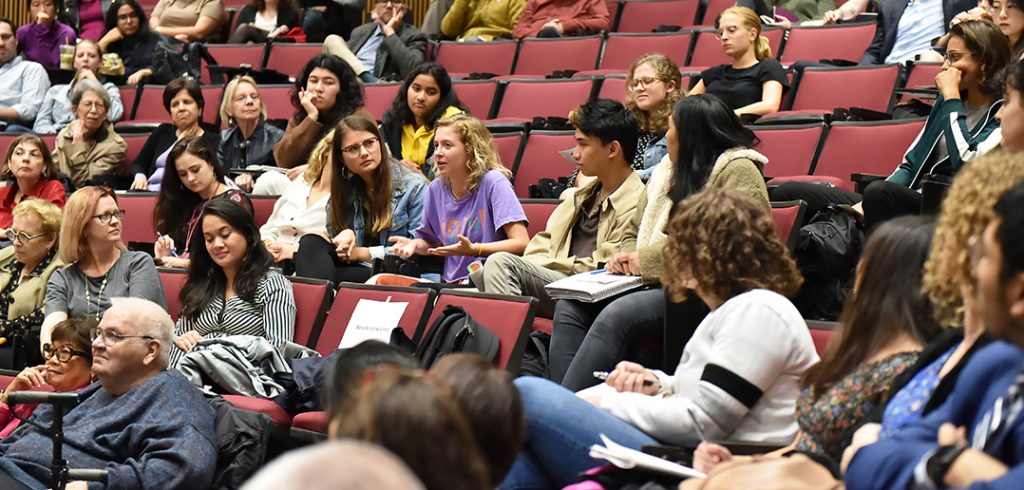“My particular mission is to wander the length and breadth of the city in search of different kinds of places: Chinese, African, and Polish, the unexpected and undersold,” she said in her talk, titled “Off the Rails in Hungry City: Confessions of an Accidental Food Writer.”

She said the food she reviews could come from a restaurant, a stall, a cart, or a truck, and, more than likely, it’ll be from an outer borough. It could be a Brooklyn pizzeria with a “sideline” in Egyptian pastry, she said, or Tibetan soup served from the back of a T-Mobile store.
“These are places where you might eat standing up or sometimes there’s only one person at the stove for whom cooking is less art than urgency,” she said.
She added that the “gig isn’t glamorous.” She often spends more time on the subway than on the meal.
“Still, I won’t lie, this job is exactly as cool as everybody thinks,” she said. “What makes it cool isn’t just the food; it’s the stories I hear. When I go to these places I’m getting entrée not only to a cuisine, but to a part of the city and the world that I wouldn’t otherwise have a chance to know.”

She described a journey that began with a childhood in Hawaii drinking Tang and eating Kraft mac and cheese “gussied up with frozen peas and crispy strips of Spam—an underrated meat product.” Her father had a wartime habit of rationing for himself the treat of canned peaches and cottage cheese. Her mother, who survived the Japanese occupation of the Philippines, didn’t know how to make a pot of rice when she arrived in the U.S., which was common for an educated woman in her country. Both her parents were sitting in the front row for the lecture and nodded knowingly; also in attendance were her husband and daughter.
Mishan began her career after graduate school at an ad agency, with no thoughts of food writing. She eventually moved on to become a book synopsis writer at the New Yorker, where she didn’t get a byline. There, she asked her editor if she could write restaurant reviews, a subject that didn’t have the same cachet a decade ago than it does now. Eventually, a New York Times editor contacted her to say, simply, “I like the way you write.”
“If I have any advice to give to you, the students here who are standing at the threshold of your adult lives, it would be this: Whatever your achievements, whatever your talents, you may not yet know what you’re really good at, but whatever path you imagine lies before you … there really is no path.”
As she waxed poetic about skewered beef tenders sold beneath the Manhattan Bridge, audience members took copious notes on their event programs.
The places she reviews are often so overlooked, she said, that when she tells them they are going to be reviewed by The New York Times, they’re often in shock.
“One chef hugged me on the spot, one chef cried,” she said.

The event drew students, members of the Department of English faculty, and University alumni, who participated in a Q&A following the lecture. One student observed that a good review has the potential to change a neighborhood, and not always in the best way for locals. She asked Mishan for her thoughts on the economic opportunities her columns foster, as well as the downside of regulars no longer being able to afford increased prices. Mishan acknowledged the issue. She said she’s written about places and seen them close because of rising rents. She wondered aloud if her column created “pressure” on the market. However, she said, she tends to focus on places so far from central Manhattan that only the diehard food fans show up and that’s good for owners who aren’t making that much money.
“It’s such a benefit for people who run the restaurant to have that crowd, even though they’ve lost their regulars,” she said. “I feel that it’s in their [the owner’s] court, they need to make people feel welcome and find a way. I don’t begrudge them the higher prices because it’s subsistence.”
Many of New York’s immigrant chefs, she said, have fled war, persecution, and famine. She noted that as many middle-class New Yorkers abandoned the city during the 1970s, they were replaced by 850,000 immigrants who called New York home. The number of sidewalk vendors doubled between 1979 and 1982, she said.
“The government was championing free trade around the globe, but New Yorkers were living it on the curb and at the corner bodega … and we still are.”


